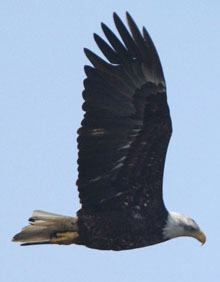Salute to Bald Eagles over Independence Day


In addition to hamburgers, hot dogs, and fireworks during this past week’s Independence Day holiday, one thing you may have enjoyed, if you were very lucky, was the sight of a Bald Eagle – something that would have been very unlikely only a generation ago.
In the minds of most Americans, there is no more conspicuous symbol of freedom than our national bird and U.S. National Emblem, the majestic Bald Eagle or Haliaeetus leucocephalus. Its size, and dark plumage accented with a striking white tail and head (adult birds), yellow eyes, beak and feet, all but guarantee you can’t mistake it for anything else.
While the adult birds are definitely spectacular, the immature birds are mostly mottled with patches of white ranging to nearly all dark brown – still big, but not nearly as majestic. The Bald Eagle is considered by some to be the largest true raptor in North America. A mature female Bald Eagle averages around 12 pounds in weight, about 25 percent heavier than her male counterpart, and has a wingspan of up to seven-and-a-half feet.
Bald Eagles are considered sea eagles unlike the similar-sized Golden Eagle which is a land eagle. The Bald Eagle is much larger than the Turkey Vulture. In flight the Bald Eagle soars with its wings flat, like a board, while the Turkey Vulture soars with its wings upward in slight “V” as seen from head-on or from behind. They make gigantic nests, perhaps the largest made by any bird, generally in dead trees.
Most of their diet consists of fish that they catch, find floating, or steal from other birds. They have few predators, with the big exception of humans.
In Ohio, the marshes in the western Lake Erie basin comprise the Bald Eagles’ stronghold, but they can also be found more and more frequently throughout the state, particularly in winter.

Today the Bald Eagle can be found in every U.S. state with the exception of Hawaii, and throughout most of Canada and northern Mexico, and even far eastern Russia, but just a few decades ago there were many who thought they were going to be extirpated from the United States, or even go extinct.
In the early 1800s the Bald Eagle population was estimated at up to a half-million birds, but by the 1950s that population had plummeted to only a few hundred breeding pairs in the lower 48 states – largely due to pesticides, habitat loss, lead poisoning, and legal and illegal shooting (according to the U.S. Fish and Wildlife Service). The Bald Eagle was declared endangered in 1967, and the pesticide DDT was banned in the U.S. in 1972 and in Canada in 1989.
Humans almost drove the Bald Eagle into extinction, and humans also brought it back, but still the Bald Eagle’s biggest predator is human activity, oftentimes intentionally through shooting or accidentally through wire and automobile strikes. The wind electric generation industry kills a number of Bald Eagles annually, although the exact number killed seems to depend upon how one feels about windmills. For the record, in 2016 the same Federal government represented by the Bald Eagle permitted the industry to kill up to 126,000 Bald Eagles (or 4,200 Bald Eagles per year for up to 30 years). In fairness to the wind electric generating industry, they are apparently attempting to reduce the number of bird and bat strikes.
In one of the greatest comeback stories ever, the Bald Eagle was removed from the List of Endangered and Threatened Wildlife in the lower 48 states in June, 2007, and is today considered a species of “least concern” by the International Union for Conservation of Nature. However they are still protected under several laws including the Bald and Golden Eagle Protection Act of 1940, the Migratory Bird Treaty Act of 1918 between the U.S., Canada, Mexico, and Russia, and the Lacy Act of 1900 which makes it a Federal offense to take, possess, transport, sell, import, or export their nests, eggs and parts.
Bald eagle populations have soared in Ohio. In 1979 the Ohio Division of Wildlife counted only four breeding pairs in the state, and in 2017 there were 221 breeding pairs that produced an estimated 230 young. The fewer-than-500 breeding pairs reported in the lower 48 states by the USFWS in the early 1950s had grown into more than 9,700 breeding pairs in 2007.
The first time I saw a Bald Eagle in the wild was about 15 years ago at a wildlife area near Sandusky Bay, and my first local sighting was perhaps eight years ago at the old Meigs Mine impoundments in the western end of the county. I have also seen them along the Ohio River near Long Bottom, Minersville, and Ravenswood, W.Va. Another Bald Eagle occasionally hangs out near the mouth of Kyger Creek in Gallia County.
If you haven’t seen one of these awesome symbols of freedom in your area, just keep your eyes to the skies, because someday soon you just might!
Jim Freeman is the wildlife specialist for the Meigs Soil and Water Conservation District. He can be contacted weekdays at 740-992-4282 or at [email protected]








